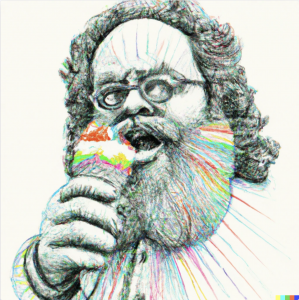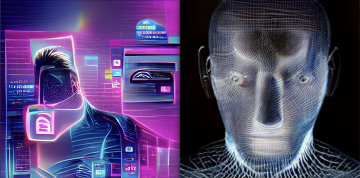When you think of creating art, you may picture someone delicately painting a portrait on a canvas, or perhaps someone snapping photos of a sunset. You probably don’t think of artificial intelligence creating a “psychedelic pencil sketch of karl marx eating ice cream” or a photorealistic image of a “gaming chair as a toilet”. With AI image generators, this is all possible.
In this article, we will discuss AI image generators—their problems and potential. Credit and attribution are two primary issues that arise with AI image generators. Bias in artificial intelligence is also ever-present, and image generators are not immune to this. However, we will also address many interesting opportunities that arise with AI image generators.
What is An AI Image Creator?
AI image generators are a category of websites and software that can create images based on prompts or based on photographs. In the past year different platforms have emerged which can generate images using data scraped from the Internet. Examples of AI image generators include Deep Dream Generator, NightCafe, Craiyon, and Art Breeder. One of the most sophisticated of these tools has been gaining popularity online this past year. DALL-E 2—a project from Open AI—is “a generative language model that takes sentences and creates corresponding original images”. With DALL-E, you can enter a prompt of any image you would like it to create, and it will create multiple images representing your prompt. It’s also possible to edit an existing photo—so you can make it look like mice are have a birthday party on your bed.

“Psychedelic Pencil Sketch of Karl Marx Eating Ice Cream” by Tobias, created with DALL-E 2
Who should be credited with the creation of AI-created images?
There has been much debate as to whether the DALL-E or other AI art generators should be credited as the artist, or if the credit should be given to the person operating the software. After all, the user is just entering prompts into a search bar. However, AI image generators are pulling from images and artwork that is already online, so is it really “creating” art?
Some have opted to view AI image creators as another tool that an artist may use—such as paintbrushes and paint, or a camera. If an artist were to create a painting, we wouldn’t say that the credit should go to their brushes. When cameras were first created, some people argued that the camera was doing all the work, and thought photographers should not have been considered artists. With this new software, users have to fiddle with prompts, and can create variants of the AI-generated creations by further editing them. Should the person doing this work be credited as the “artist”?
“If an artist were to create a painting, we wouldn’t say that the credit should go to their brushes”
As convincing and stunning as the creations with some AI generated images (specifically DALL-E 2) are, there is always the risk that people will try and pass off ai-generated art as their own painting, sketch, or photograph. Do you think that an artist should have to indicate that their work is created with the help of an AI image generator?
What are the limitations and problems?
-
Composition
While DALL-E (and other AI image generators) are great at creating abstract art, they don’t respond as well to extremely specific composition prompts. For example, if you enter “a green triangle on top of a large red square beside a small blue sphere”, it may put the triangle on the bottom, or switch around the colours.
-
Bias
A more pervasive issue in AI (DALL-E included) is bias. Because AI image creators are trained on open-source images taken from the internet, societal biases that are presented online are also present in the code. For example, when prompted to create images of people in prison, DALL-E 2 overwhelmingly creates images of men of colour. OpenAI (the creators of DALL-E) has circumvented this problem by not showing certain sensitive images on the platform.
Applications of AI Image Creators
Other than the endless twitter threads that have been circulating with DALL-E created images, there have been some interesting applications of this software. For instance, Heinz has launched an ad campaign using DALL-E-created images of ketchup bottles that closely resemble Heinz bottles.
We ran some prompts through AI image creators to see what they would come up with. Here were the results:

“Digital Tattoo” as conceived by NightCafe (left) and Craiyon (right)

“Digital Identity” as conceived by NightCafe (left) and Craiyon (right)
While some of the images are certainly odd, they show the potential of this type of AI software.
Have you used any AI image creators? We would love to hear about your experience! Do you have a favourite software? Any particularly interesting images? Let us know in the comments below!
Written by: Eden Solarik
Edited by: Lucas Wright
Cover Photo: “Digital Identity” prompt in NightCafe

